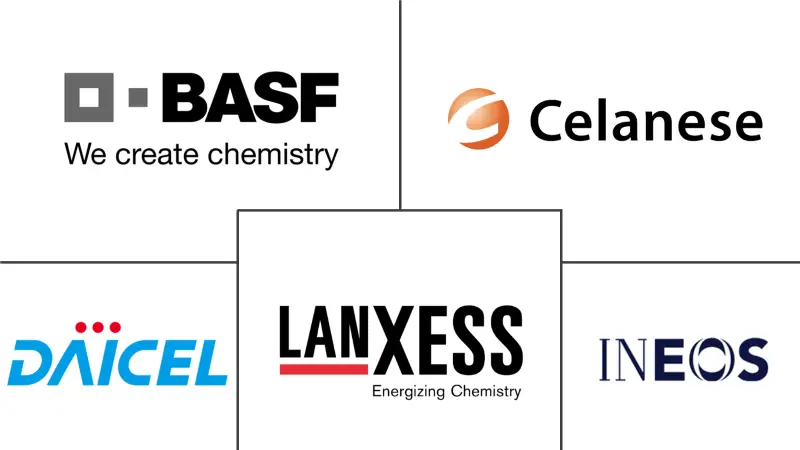Market Size of Thermosetting Plastics Industry

| Study Period | 2019 - 2029 |
| Base Year For Estimation | 2023 |
| CAGR | < 5.00 % |
| Fastest Growing Market | Asia Pacific |
| Largest Market | Asia Pacific |
| Market Concentration | Low |
Major Players
*Disclaimer: Major Players sorted in no particular order |
Thermosetting Plastics Market Analysis
The market for thermosetting plastics is expected to witness a CAGR of a little less than 5% during the forecast period.
- The COVID-19 pandemic negatively impacted the market. Given the pandemic, construction projects were temporarily halted to prevent the spread, limiting demand for thermosetting plastic materials. However, the industry picked up speed in 2021, and the market is expected to follow a similar trajectory throughout the projection decade.
- The expanding construction sector in Asia-Pacific is a primary driver of the market under consideration. Furthermore, increased demand for polyurethane in the automotive industry is expected to boost the market growth. On the contrary, stringent government regulations on the usage of thermosetting plastics as a material are likely to hamper the growth of the market studied.
- The growing demand for bio-based thermosetting plastics will likely act as an opportunity for market growth in the coming years. Asia-Pacific dominates the global market, with the largest consumption from countries such as China and India.
Thermosetting Plastics Industry Segmentation
A prepolymer known as a thermosetting polymer, also called a thermoset, is created by permanently hardening a soft solid or viscous liquid. Thermoset plastics are man-made materials that strengthen when heated but cannot be successfully remolded or reheated once heat-formed or molded.
The thermosetting plastics market is segmented by type, end-user industry, and geography. By type, the market is segmented into unsaturated polyesters, polyurethanes, phenolic, epoxy, amino, alkyd, vinyl ester, and other types. By end-user industry, the market is segmented into construction, adhesives and sealants, electronics and appliances, automotive, and other end-user industries. The report also covers the market size and forecasts for the thermosetting plastics market in 15 countries across major regions.
For each segment, the market sizing and forecasts have been done based on revenue (USD million).
| Type | |
| Unsaturated Polyesters | |
| Polyurethanes | |
| Phenolic | |
| Epoxy | |
| Amino | |
| Alkyd | |
| Vinyl Ester | |
| Other Types |
| End-user Industry | |
| Construction | |
| Adhesive and Sealants | |
| Electronics and Appliances | |
| Automotive | |
| Other End-user Industries |
| Geography | |||||||
| |||||||
| |||||||
| |||||||
| |||||||
|
Thermosetting Plastics Market Size Summary
The thermosetting plastics market is poised for steady growth, driven by the expanding construction sector in the Asia-Pacific region and increased demand in the automotive industry. These materials, known for their excellent properties such as chemical and heat resistance, are extensively used in construction applications, including adhesives, sealants, and thermal insulation. The market experienced a downturn due to the COVID-19 pandemic, which temporarily halted construction projects, but has since rebounded and is expected to continue on an upward trajectory. Despite the positive outlook, the market faces challenges from stringent government regulations regarding the use of thermosetting plastics. However, the rising demand for bio-based alternatives presents a significant opportunity for future growth.
Asia-Pacific dominates the global thermosetting plastics market, with substantial consumption in countries like China and India. The region's construction industry is a major contributor to market expansion, supported by rapid urbanization and increased infrastructure spending. Additionally, the automotive sector's demand for polyurethane is expected to further boost market growth. The market is characterized by fragmentation, with no single company holding a dominant share. Key players, including Celanese Corporation, LANXESS, DAICEL CORPORATION, INEOS, and BASF SE, are employing various strategies to cater to consumer needs. Recent acquisitions, such as Prince International Corporation's acquisition of Ferro Corporation and Chromaflo Technologies, highlight ongoing consolidation efforts within the industry.
Thermosetting Plastics Market Size - Table of Contents
-
1. MARKET DYNAMICS
-
1.1 Drivers
-
1.1.1 Growing Construction Industry in Asia-Pacific
-
1.1.2 Rising Demand for Polyurethane in the Automotive Industry
-
-
1.2 Restraints
-
1.2.1 Stringent Government Regulations
-
1.2.2 Other Restraints
-
-
1.3 Industry Value Chain Analysis
-
1.4 Porter's Five Forces Analysis
-
1.4.1 Bargaining Power of Suppliers
-
1.4.2 Bargaining Power of Consumers
-
1.4.3 Threat of New Entrants
-
1.4.4 Threat of Substitute Products and Services
-
1.4.5 Degree of Competition
-
-
1.5 Technological Snapshot
-
-
2. MARKET SEGMENTATION (Market Size in Value)
-
2.1 Type
-
2.1.1 Unsaturated Polyesters
-
2.1.2 Polyurethanes
-
2.1.3 Phenolic
-
2.1.4 Epoxy
-
2.1.5 Amino
-
2.1.6 Alkyd
-
2.1.7 Vinyl Ester
-
2.1.8 Other Types
-
-
2.2 End-user Industry
-
2.2.1 Construction
-
2.2.2 Adhesive and Sealants
-
2.2.3 Electronics and Appliances
-
2.2.4 Automotive
-
2.2.5 Other End-user Industries
-
-
2.3 Geography
-
2.3.1 Asia-Pacific
-
2.3.1.1 China
-
2.3.1.2 India
-
2.3.1.3 Japan
-
2.3.1.4 South Korea
-
2.3.1.5 Rest of Asia-Pacific
-
-
2.3.2 North America
-
2.3.2.1 United States
-
2.3.2.2 Canada
-
2.3.2.3 Mexico
-
-
2.3.3 Europe
-
2.3.3.1 Germany
-
2.3.3.2 United Kingdom
-
2.3.3.3 Italy
-
2.3.3.4 France
-
2.3.3.5 Rest of Europe
-
-
2.3.4 South America
-
2.3.4.1 Brazil
-
2.3.4.2 Argentina
-
2.3.4.3 Rest of South America
-
-
2.3.5 Middle-East and Africa
-
2.3.5.1 Saudi Arabia
-
2.3.5.2 South Africa
-
2.3.5.3 Rest of Middle-East and Africa
-
-
-
Thermosetting Plastics Market Size FAQs
What is the current Thermosetting Plastics Market size?
The Thermosetting Plastics Market is projected to register a CAGR of less than 5% during the forecast period (2024-2029)
Who are the key players in Thermosetting Plastics Market?
Celanese Corporation, LANXESS, DAICEL CORPORATION, INEOS and BASF SE are the major companies operating in the Thermosetting Plastics Market.

